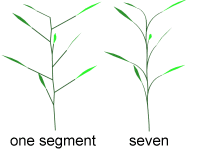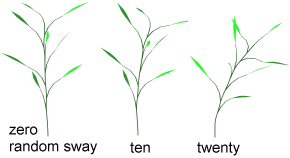General parameters
The parameters in the General parameters section determine some major decisions about the plant’s shape, biomass1UCKPV3 accumulation, and life cycle.
Number of segments to draw to create curved line
This number is used to create the appearance of graceful curves for all stems on the plant. To see how it works, set the number to 1 – your plant will appear all stiff and awkward. A value of three segments per curved line seems to be the minimum for reasonable curviness, but you might like to set this even higher. Because of rounding, changing this number will have some impact on the angles of a plant.

Random sway in drawing angles
This number determines how much angles on the plant vary – specifically angles of leaves, flowers and branches in inflorescences, and internodes (the angle between one internode and the next). If you want a plant with precise angles, set this parameter to zero. Setting this parameter to 90 degrees will produce a plant with such bizarre angles that it probably will look like a contortionist. Usually a value less than ten degrees will be about right.

Age at maturity
You can set this age at any number you want, but since there are many timing parameters throughout the system (such as Internodes: Minimum days to grow) you will usually want to keep it at least above 35 days. Increasing the maturity age to a high number can help you simulate second-year growth or simulate a shrub. However, a plant with such a long life cycle will probably take a very long time to draw and may not animate well. The best life-cycle length is about 100 days.
Growth curve
The growth curve parameter is mentioned in the section on How a plant growsHow_a_plant_grows>second.
Age at which flowering starts
This parameter determines when the plant will switch all active meristems over to reproductive mode and start creating inflorescences. If you want to see flowers on your plant, make sure that this value is less than the Age at maturity value and that you’ve left enough time before the Age at maturity for the flowers (and fruits if you want them) to form.
Fraction of total plant biomass at maturity in reproductive structures
For most plants this value will be between 0.4 and 0.6. The value you choose will depend on how you allocate biomass between the plant parts (by setting the Optimal final biomass parameters) and on timing parameters. Try changing it to see what affect it has on the plant and on the Stats panelUsing_the_Stats_panel_to_evaluate_biomass_distribution>second.
Plant has both primary and secondary flowers
You will need to set this parameter to “yes” for very few plants. If this parameter is set to “no”, you can ignore the entire Secondary Inflorescences and Secondary Flowers parameter sections. Primary flowers have both male and female parts; secondary flowers have only male parts and do not develop into fruits. The corn plant in the file “Garden plants.pla” gives an example of creating a plant with separate primary and secondary flowers.
Plant is dicotyledonous (has two seedling leaves)
As mentioned in our section on botanical strengths and limitations1R_5ZID>main, PlantStudio simulates the differences between monocots (with one seedling leaf) and dicots (with two seedling leaves) only superficially. If you answer this parameter with a “yes”, two seedling leaves will be drawn. If you answer this parameter with a “no”, one seedling leaf will be drawn. That is the only difference between monocots and dicots.
Number of apical (terminal) inflorescences, Number of axillary inflorescences
These two parameters place inflorescences on the plant. The number of inflorescences is done with brute force here because probabilistic methods produce too much variation. In reality the number of inflorescences on plants of a variety does vary, but not much. You must choose a number to place on the plant based on how many meristems of the correct type (apical or axillary) you expect to be available. These examples will help.
▪ If you are creating a sunflower with only one head, you will set the parameter General parameters: Number of apical (terminal) inflorescences to one.
▪ If you are creating an ornamental sunflower with multiple heads, each at the end of a stem, you will set the parameter General parameters: Number of apical (terminal) inflorescences to (say) five. However, you will only see five heads on the sunflower if there are five apical meristems. To get five apical meristems you have to have enough branching to create that many. So you would set the parameter Meristems: Branching index to about 20-30%. By playing with these two parameters you can arrive at a situation that creates the number of inflorescences you want.
Phyllotactic rotation angle
This angle is the angle between successive leaves on a stem (going around the stem). For the vast majority of plants a rotation angle of 137.5 degrees is correct. For some grassy plants the angle should be 180 degrees (this-way-that-way). Though it’s not strictly botanically accurate, you can play with this number to create some interesting effects for viny or underwater plants.
Starting seed for random number generator
This number drives all the random choices the plant makes when it is growing, mainly choices about branching and about angles. When you randomize a plant, this number changes. The manifestation of randomness depends heavily on the parameter General parameters: Random sway in drawing angles, because if that number is zero no randomness will occur.
Created with the Personal Edition of HelpNDoc: Easy EBook and documentation generator